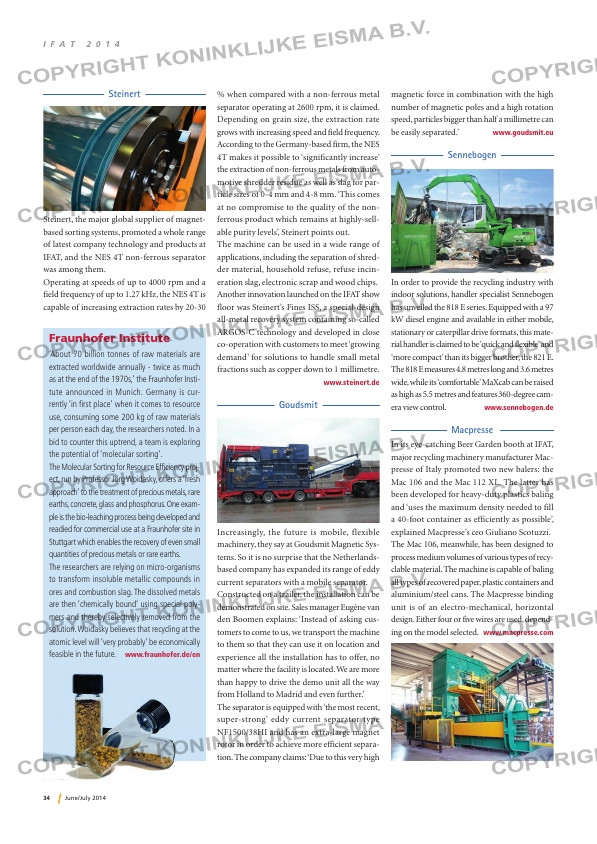Page 34 from: June / July 2014

34 June/July 2014
I F A T 2 0 1 4
Steinert
Steinert, the major global supplier of magnet-
based sorting systems, promoted a whole range
of latest company technology and products at
IFAT, and the NES 4T non-ferrous separator
was among them.
Operating at speeds of up to 4000 rpm and a
field frequency of up to 1.27 kHz, the NES 4T is
capable of increasing extraction rates by 20-30
% when compared with a non-ferrous metal
separator operating at 2600 rpm, it is claimed.
Depending on grain size, the extraction rate
grows with increasing speed and field frequency.
According to the Germany-based firm, the NES
4T makes it possible to ‘significantly increase’
the extraction of non-ferrous metals from auto-
motive shredder residue as well as slag for par-
ticle sizes of 0-4 mm and 4-8 mm. ‘This comes
at no compromise to the quality of the non-
ferrous product which remains at highly-sell-
able purity levels’, Steinert points out.
The machine can be used in a wide range of
applications, including the separation of shred-
der material, household refuse, refuse incin-
eration slag, electronic scrap and wood chips.
Another innovation launched on the IFAT show
floor was Steinert’s Fines ISS, a special-design
all-metal recovery system containing so-called
ARGOS-C technology and developed in close
co-operation with customers to meet ‘growing
demand’ for solutions to handle small metal
fractions such as copper down to 1 millimetre.
www.steinert.de
Goudsmit
Increasingly, the future is mobile, flexible
machinery, they say at Goudsmit Magnetic Sys-
tems. So it is no surprise that the Netherlands-
based company has expanded its range of eddy
current separators with a mobile separator.
Constructed on a trailer, the installation can be
demonstrated on site. Sales manager Eugène van
den Boomen explains: ‘Instead of asking cus-
tomers to come to us, we transport the machine
to them so that they can use it on location and
experience all the installation has to offer, no
matter where the facility is located. We are more
than happy to drive the demo unit all the way
from Holland to Madrid and even further.’
The separator is equipped with ‘the most recent,
super-strong’ eddy current separator type
NF1500/38HI and has an extra-large magnet
rotor in order to achieve more efficient separa-
tion. The company claims: ‘Due to this very high
magnetic force in combination with the high
number of magnetic poles and a high rotation
speed, particles bigger than half a millimetre can
be easily separated.’ www.goudsmit.eu
Sennebogen
In order to provide the recycling industry with
indoor solutions, handler specialist Sennebogen
has unveiled the 818 E series. Equipped with a 97
kW diesel engine and available in either mobile,
stationary or caterpillar drive formats, this mate-
rial handler is claimed to be ‘quick and flexible’ and
‘more compact’ than its bigger brother, the 821 E.
The 818 E measures 4.8 metres long and 3.6 metres
wide, while its ‘comfortable’ MaXcab can be raised
as high as 5.5 metres and features 360-degree cam-
era view control. www.sennebogen.de
Macpresse
In its eye-catching Beer Garden booth at IFAT,
major recycling machinery manufacturer Mac-
presse of Italy promoted two new balers: the
Mac 106 and the Mac 112 XL. The latter has
been developed for heavy-duty plastics baling
and ‘uses the maximum density needed to fill
a 40-foot container as efficiently as possible’,
explained Macpresse’s ceo Giuliano Scotuzzi.
The Mac 106, meanwhile, has been designed to
process medium volumes of various types of recy-
clable material. The machine is capable of baling
all types of recovered paper, plastic containers and
aluminium/steel cans. The Macpresse binding
unit is of an electro-mechanical, horizontal
design. Either four or five wires are used, depend-
ing on the model selected. www.macpresse.com
Fraunhofer Institute
‘About 70 billion tonnes of raw materials are
extracted worldwide annually – twice as much
as at the end of the 1970s,’ the Fraunhofer Insti-
tute announced in Munich. Germany is cur-
rently ‘in fi rst place’ when it comes to resource
use, consuming some 200 kg of raw materials
per person each day, the researchers noted. In a
bid to counter this uptrend, a team is exploring
the potential of ‘molecular sorting’.
The Molecular Sorting for Resource Effi ciency proj-
ect, run by Professor Jörg Woidasky, offers a ‘fresh
approach’ to the treatment of precious metals, rare
earths, concrete, glass and phosphorus. One exam-
ple is the bio-leaching process being developed and
readied for commercial use at a Fraunhofer site in
Stuttgart which enables the recovery of even small
quantities of precious metals or rare earths.
The researchers are relying on micro-organisms
to transform insoluble metallic compounds in
ores and combustion slag. The dissolved metals
are then ‘chemically bound’ using special poly-
mers and thereby selectively removed from the
solution. Woidasky believes that recycling at the
atomic level will ‘very probably’ be economically
feasible in the future. www.fraunhofer.de/en
RI-5-IFAT.indd 34 16-06-14 11:52



